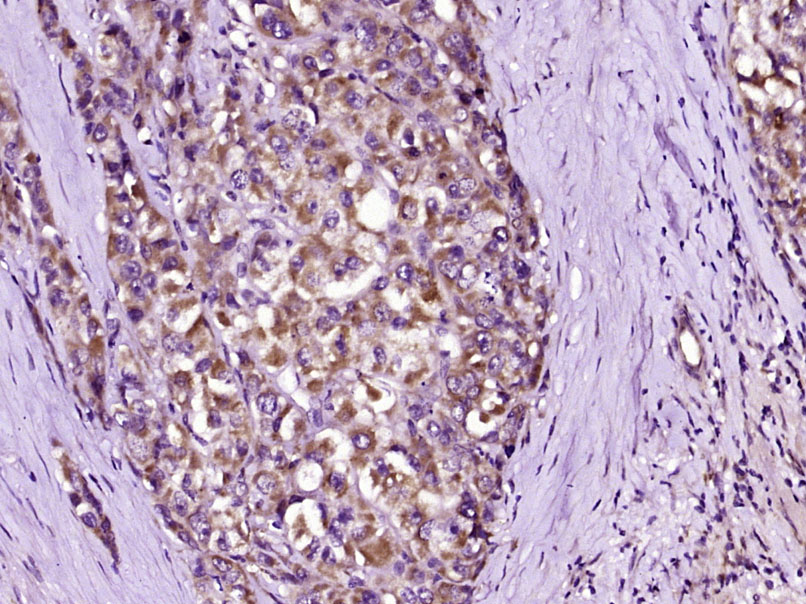
Rabbit Anti-C1 Inactivator antibody
C1 esterase inhibitor; C1 INH; C1 inhibitor; C1-inhibiting factor; C1IN; C1Inh; C1NH; esterase inhibitor; HAE1; IC1_HUMAN; Plasma protease C1 inhibitor; Serine (or cysteine) proteinase inhibitor clade G member 1; Serpin G1; SERPING1.
View History [Clear]
Details
Product Name C1 Inactivator Chinese Name 酯酶抑制蛋白C1IN抗体 Alias C1 esterase inhibitor; C1 INH; C1 inhibitor; C1-inhibiting factor; C1IN; C1Inh; C1NH; esterase inhibitor; HAE1; IC1_HUMAN; Plasma protease C1 inhibitor; Serine (or cysteine) proteinase inhibitor clade G member 1; Serpin G1; SERPING1. Research Area Cardiovascular immunology Immunogen Species Rabbit Clonality Polyclonal React Species Human, (predicted: Mouse, Rat, Dog, Pig, Cow, Guinea Pig, ) Applications WB=1:500-2000 ELISA=1:5000-10000 IHC-P=1:100-500 IHC-F=1:100-500 IF=1:100-500 (Paraffin sections need antigen repair)
not yet tested in other applications.
optimal dilutions/concentrations should be determined by the end user.Theoretical molecular weight 53kDa Cellular localization Secretory protein Form Liquid Concentration 1mg/ml immunogen KLH conjugated synthetic peptide derived from human SERPING1: 401-500/500 Lsotype IgG Purification affinity purified by Protein A Buffer Solution 0.01M TBS(pH7.4) with 1% BSA, 0.03% Proclin300 and 50% Glycerol. Storage Shipped at 4℃. Store at -20 °C for one year. Avoid repeated freeze/thaw cycles. Attention This product as supplied is intended for research use only, not for use in human, therapeutic or diagnostic applications. PubMed PubMed Product Detail C1 Inactivator is a highly glycosylated plasma protein involved in the regulation of the complement cascade. Its protein inhibits activated C1r and C1s of the first complement component and thus regulates complement activation. Deficiency of this protein is associated with hereditary angioneurotic oedema (HANE). Alternative splicing results in multiple transcript variants encoding the same isoform.
Function:
Activation of the C1 complex is under control of the C1-inhibitor. It forms a proteolytically inactive stoichiometric complex with the C1r or C1s proteases. May play a potentially crucial role in regulating important physiological pathways including complement activation, blood coagulation, fibrinolysis and the generation of kinins. Very efficient inhibitor of FXIIa. Inhibits chymotrypsin and kallikrein.
Subunit:
Binds to E.coli stcE which allows localization of SERPING1 to cell membranes thus protecting the bacteria against complement-mediated lysis. Interacts with MASP1.
Subcellular Location:
Secreted.
Post-translational modifications:
Highly glycosylated (49%) with N- and O-glycosylation. O-glycosylated with core 1 or possibly core 8 glycans. N-glycan heterogeneity at Asn-25: Hex5HexNAc4 (minor), dHex1Hex5HexNAc4 (minor), Hex6HexNAc5 (major) and dHex1Hex6HexNAc5 (minor).
Can be proteolytically cleaved by E.coli stcE.
DISEASE:
Defects in SERPING1 are the cause of hereditary angioedema (HAE) [MIM:106100]; also called hereditary angioneurotic edema (HANE). HAE is an autosomal dominant disorder characterized by episodic local subcutaneous edema and submucosal edema involving the upper respiratory and gastrointestinal tracts. HAE due to C1 esterase inhibitor deficiency is comprised of two clinically indistinguishable forms. In HAE type 1, representing 85% of patients, serum levels of C1 esterase inhibitor are less than 35% of normal. In HAE type 2, the levels are normal or elevated, but the protein is non-functional.
Similarity:
Belongs to the serpin family.
SWISS:
P05155
Gene ID:
710
Database links:Entrez Gene: 710 Human
Entrez Gene: 12258 Mouse
Omim: 606860 Human
SwissProt: P05155 Human
SwissProt: P97290 Mouse
Unigene: 384598 Human
Unigene: 38888 Mouse
Unigene: 100285 Rat
Product Picture
References (0)
No References
Bought notes(bought amounts latest0)
No one bought this product
User Comment(Total0User Comment Num)
- No comment



 +86 571 56623320
+86 571 56623320
 +86 18668110335
+86 18668110335

